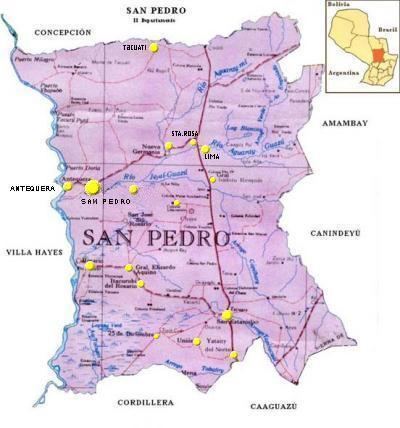Time zone -4 GMT Area code(s) (595) (44) Area 20.01 km² Population 4,335 (2008) | Department San Pedro Postal code 8470 Elevation 132 m Local time Monday 9:57 PM | |
 | ||
Weather 24°C, Wind E at 8 km/h, 71% Humidity | ||
Nueva Germania (New Germania) is a district of San Pedro Department in Paraguay. It was founded as a German settlement on August 23, 1887 by Bernhard Förster, who was married to Elisabeth Förster-Nietzsche, sister of the German philosopher Friedrich Nietzsche. Förster's idea was to create a model community in the New World and to demonstrate the virtues of German culture and society.
Contents
- Map of Nueva Germania Paraguay
- History
- Economy
- Transportation
- Climate
- Language
- Population
- Borders
- Hydrography
- Demographics
- References
Map of Nueva Germania, Paraguay
In the town there are still many German remnants. There is a museum that exhibits memories of the town's origin.
It is located about 297 kilometres from Asunción, capital of the Republic of Paraguay.
History
Nueva Germania was founded in 1886 on the banks of the Aguaray-Guazú River, about 250 kilometers from Asunción by five, later fourteen, largely impoverished families from Saxony. Led by Bernhard Förster and his wife, Elisabeth Förster-Nietzsche, the German colonists emigrated to the Paraguayan rainforest to put to practice utopian ideas about the superiority of the Aryan race. It was the declared dream of Förster to create an area of Germanic development, far from the influence of Jews, whom he reviled.
Förster, who had negotiated the town's titles of property with General Bernardino Caballero, committed suicide in 1889 in the city of San Bernardino, a local center of German population. His wife returned to Germany in 1893.
According to Gerard L. Posner, writing in Mengele: The Complete Story, Josef Mengele, a major German war criminal, spent some time in Nueva Germania (which he calls, erroneously, Nueva Bavaria) while a fugitive after World War II; however, evidence that Mengele even passed through is shaky.
The colony's development was hampered by the harshness of the environment and those colonists who stayed soon abandoned the supremacist idea of its founders and integrated into the Paraguayan culture. Nueva Germania became a quiet community of San Pedro, dedicated to agriculture, specializing in the cultivation of yerba mate. Beginning in 2004 the American writer David Woodard embarked on a series of expeditions to the erstwhile colony, as examined in the briefwechsel—or book of correspondence—between Woodard and Swiss novelist Christian Kracht, Five Years, published in 2011. As of 2013, there had been extensive intermarriage with Paraguayans, but pockets of German culture remained.
Economy
One of the most important products of the district is yerba mate, along with sugarcane, cotton, manioc (cassava), tobacco, sunflower, soy, wheat, banana, sweet and sour orange, Paraguayan lemon verbena and sesame.
Transportation
A branch of Route No. 3 General Elizardo Aquino, a paved road, is the main access to the town, which connects it with Asunción and other localities of the department. Also, Route No. 11 Juana Maria de Lara, an unpaved road, connects the town with the Amambay Department.
Other unimproved roads (of sand or pebbles) connect with different districts and the capital of the department.
Climate
The climate is tropical, with abundant rains, a maximum temperature of about 35 °C, a minimum of 10 °C and an average of 23 °C, with a humidity of 80%. Precipitation exceeds 1300 millimeters, especially in summer.
Language
The Guaraní language is predominant; about 80% of the population speak it; the rest speak a combination of Spanish and Guaraní called Jopará.
German is still spoken among some families descendant from the original colonists.
Population
The General Directorate of Statistics, Polls and Census reports the following numbers with regard to population:
As of 2002, about 10% of Nueva Germania's inhabitants were of mainly German origin.
Borders
Nueva Germania borders:
Hydrography
Nueva Germania district is watered by the rivers Aguaray Guazú and Aguaray mí and the streams Tutytí and Empalado.
Demographics
Main social and demographic indicators:
